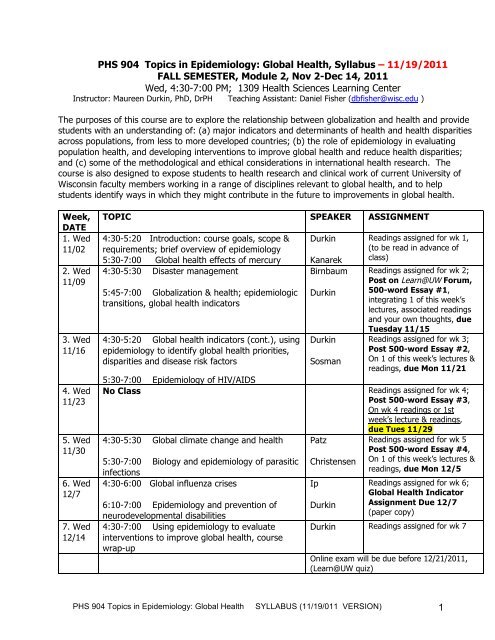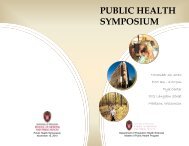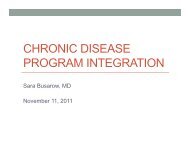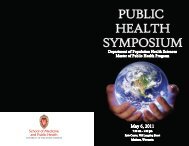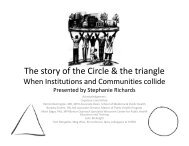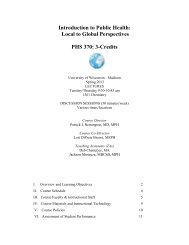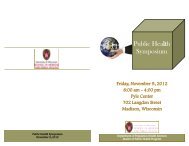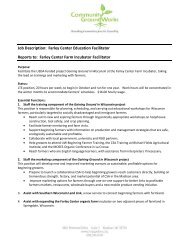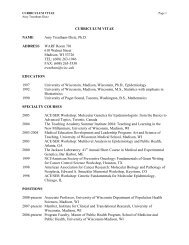PHS 904 Topics in Epidemiology: Global Health, Syllabus
PHS 904 Topics in Epidemiology: Global Health, Syllabus
PHS 904 Topics in Epidemiology: Global Health, Syllabus
You also want an ePaper? Increase the reach of your titles
YUMPU automatically turns print PDFs into web optimized ePapers that Google loves.
<strong>PHS</strong> <strong>904</strong> <strong>Topics</strong> <strong>in</strong> <strong>Epidemiology</strong>: <strong>Global</strong> <strong>Health</strong>, <strong>Syllabus</strong> – 11/19/2011<br />
FALL SEMESTER, Module 2, Nov 2-Dec 14, 2011<br />
Wed, 4:30-7:00 PM; 1309 <strong>Health</strong> Sciences Learn<strong>in</strong>g Center<br />
Instructor: Maureen Durk<strong>in</strong>, PhD, DrPH Teach<strong>in</strong>g Assistant: Daniel Fisher (dbfisher@wisc.edu )<br />
The purposes of this course are to explore the relationship between globalization and health and provide<br />
students with an understand<strong>in</strong>g of: (a) major <strong>in</strong>dicators and determ<strong>in</strong>ants of health and health disparities<br />
across populations, from less to more developed countries; (b) the role of epidemiology <strong>in</strong> evaluat<strong>in</strong>g<br />
population health, and develop<strong>in</strong>g <strong>in</strong>terventions to improve global health and reduce health disparities;<br />
and (c) some of the methodological and ethical considerations <strong>in</strong> <strong>in</strong>ternational health research. The<br />
course is also designed to expose students to health research and cl<strong>in</strong>ical work of current University of<br />
Wiscons<strong>in</strong> faculty members work<strong>in</strong>g <strong>in</strong> a range of discipl<strong>in</strong>es relevant to global health, and to help<br />
students identify ways <strong>in</strong> which they might contribute <strong>in</strong> the future to improvements <strong>in</strong> global health.<br />
Week,<br />
DATE<br />
1. Wed<br />
11/02<br />
2. Wed<br />
11/09<br />
3. Wed<br />
11/16<br />
4. Wed<br />
11/23<br />
5. Wed<br />
11/30<br />
6. Wed<br />
12/7<br />
7. Wed<br />
12/14<br />
TOPIC SPEAKER ASSIGNMENT<br />
4:30-5:20 Introduction: course goals, scope &<br />
requirements; brief overview of epidemiology<br />
5:30-7:00 <strong>Global</strong> health effects of mercury<br />
4:30-5:30 Disaster management<br />
5:45-7:00 <strong>Global</strong>ization & health; epidemiologic<br />
transitions, global health <strong>in</strong>dicators<br />
4:30-5:20 <strong>Global</strong> health <strong>in</strong>dicators (cont.), us<strong>in</strong>g<br />
epidemiology to identify global health priorities,<br />
disparities and disease risk factors<br />
Durk<strong>in</strong><br />
Kanarek<br />
Birnbaum<br />
Durk<strong>in</strong><br />
Durk<strong>in</strong><br />
Sosman<br />
Read<strong>in</strong>gs assigned for wk 1,<br />
(to be read <strong>in</strong> advance of<br />
class)<br />
Read<strong>in</strong>gs assigned for wk 2;<br />
Post on Learn@UW Forum,<br />
500-word Essay #1,<br />
<strong>in</strong>tegrat<strong>in</strong>g 1 of this week’s<br />
lectures, associated read<strong>in</strong>gs<br />
and your own thoughts, due<br />
Tuesday 11/15<br />
Read<strong>in</strong>gs assigned for wk 3;<br />
Post 500-word Essay #2,<br />
On 1 of this week’s lectures &<br />
read<strong>in</strong>gs, due Mon 11/21<br />
5:30-7:00 <strong>Epidemiology</strong> of HIV/AIDS<br />
No Class Read<strong>in</strong>gs assigned for wk 4;<br />
Post 500-word Essay #3,<br />
On wk 4 read<strong>in</strong>gs or 1st<br />
week’s lecture & read<strong>in</strong>gs,<br />
due Tues 11/29<br />
4:30-5:30 <strong>Global</strong> climate change and health Patz<br />
Read<strong>in</strong>gs assigned for wk 5<br />
Post 500-word Essay #4,<br />
5:30-7:00 Biology and epidemiology of parasitic Christensen On 1 of this week’s lectures &<br />
<strong>in</strong>fections<br />
read<strong>in</strong>gs, due Mon 12/5<br />
4:30-6:00 <strong>Global</strong> <strong>in</strong>fluenza crises<br />
Ip<br />
Read<strong>in</strong>gs assigned for wk 6;<br />
<strong>Global</strong> <strong>Health</strong> Indicator<br />
6:10-7:00 <strong>Epidemiology</strong> and prevention of Durk<strong>in</strong> Assignment Due 12/7<br />
neurodevelopmental disabilities<br />
(paper copy)<br />
4:30-7:00 Us<strong>in</strong>g epidemiology to evaluate Durk<strong>in</strong> Read<strong>in</strong>gs assigned for wk 7<br />
<strong>in</strong>terventions to improve global health, course<br />
wrap-up<br />
Onl<strong>in</strong>e exam will be due before 12/21/2011,<br />
(Learn@UW quiz)<br />
<strong>PHS</strong> <strong>904</strong> <strong>Topics</strong> <strong>in</strong> <strong>Epidemiology</strong>: <strong>Global</strong> <strong>Health</strong> SYLLABUS (11/19/011 VERSION) 1
Format: lectures featur<strong>in</strong>g U.W. faculty with expertise <strong>in</strong> topics related to <strong>in</strong>ternational<br />
health; weekly read<strong>in</strong>gs; brief written assignments and discussions on assigned and<br />
student-selected topics.<br />
Grad<strong>in</strong>g:<br />
• Class attendance and participation, <strong>in</strong>clud<strong>in</strong>g completion of at least three of the four<br />
assigned Learn@UW 500-word commentaries (post<strong>in</strong>gs), 60% [Note: each of the six<br />
weekly attendances is worth seven po<strong>in</strong>ts and each commentary is worth six po<strong>in</strong>ts;<br />
students can miss either one class or one post<strong>in</strong>g and still achieve 60% (note that the<br />
fourth essay is worth seven po<strong>in</strong>ts if it is used <strong>in</strong> place of one attendance)]<br />
• <strong>Global</strong> <strong>Health</strong> Indicator Assignment, 15%<br />
• F<strong>in</strong>al Exam (take-home, on-l<strong>in</strong>e, multiple choice), 25%.<br />
Attendance: Students are expected to attend all seven weekly class sessions and sign the<br />
attendance sheet. In the event that a student has to miss a class, he or she should let the<br />
<strong>in</strong>structor and the teach<strong>in</strong>g assistant know <strong>in</strong> advance, if possible. Students can make-up for<br />
one missed weekly session by complet<strong>in</strong>g all four of the assigned commentary post<strong>in</strong>gs<br />
(<strong>in</strong>stead of the otherwise m<strong>in</strong>imum requirement of post<strong>in</strong>g three 500-word discussion<br />
pieces). Students are encouraged to read each other’s post<strong>in</strong>gs on the Learn@UW Forum;<br />
it’s possible ideas for exam questions will come from this post<strong>in</strong>gs.<br />
Lecturers:<br />
Marv<strong>in</strong> Birnbaum, MD, PhD, Emeritus<br />
Professor of Medic<strong>in</strong>e & Physiology,<br />
Director of Emergency Medical Services,<br />
UW; President of the World Association<br />
for Disaster & Emergency Medic<strong>in</strong>e<br />
Bruce Christensen, PhD, Professor,<br />
Dept of Animal <strong>Health</strong> & Biological<br />
Sciences, School of Veter<strong>in</strong>ary Medic<strong>in</strong>e<br />
UW-Madison<br />
Maureen Durk<strong>in</strong>, PhD, DrPH,<br />
Professor, Dept of Population <strong>Health</strong><br />
Sciences & Pediatrics, & Waisman Center,<br />
UW-Madison<br />
Hon Ip, PhD, Director, Diagnostic<br />
Virology Laboratory, United States<br />
Geological Survey, National Wildlife <strong>Health</strong><br />
Center, Madison, WI<br />
Marty Kanarek, PhD, Professor, Dept of<br />
Population <strong>Health</strong> Sciences & Gaylord<br />
Nelson Institute for Environmental Studies<br />
UW-Madison<br />
Jonathan Patz, MD, Professor, Dept of<br />
Population <strong>Health</strong> Sciences & Gaylord<br />
Nelson Institute for Environmental<br />
Sciences, UW-Madison<br />
James Sosman, MD, Associate Professor<br />
Dept of Medic<strong>in</strong>e, UW-Madison<br />
Lecture <strong>Topics</strong>:<br />
Disaster Management<br />
Biology and epidemiology of parasitic <strong>in</strong>fections, lymphatic<br />
filariasis, geohelm<strong>in</strong>ths, effects of preventive <strong>in</strong>terventions on<br />
child health<br />
<strong>Global</strong> health <strong>in</strong>dicators & determ<strong>in</strong>ants; globalization &<br />
health; design & conduct of global epidemiologic studies;<br />
neurodevelopmental disabilities; research ethics<br />
Virology, avian <strong>in</strong>fluenza, diagnosis, surveillance, global<br />
<strong>in</strong>fluenza epidemiology<br />
<strong>Global</strong> health effects of mercury<br />
<strong>Global</strong> climate change and health<br />
HIV/AIDS<br />
<strong>PHS</strong> <strong>904</strong> <strong>Topics</strong> <strong>in</strong> <strong>Epidemiology</strong>: <strong>Global</strong> <strong>Health</strong> SYLLABUS (11/19/011 VERSION) 2
Required READINGS (to be read <strong>in</strong> advance of each session)<br />
Week 1, Wed 11/2/2011: Course Overview & Background; <strong>Global</strong> <strong>Health</strong> Effects of<br />
Mercury<br />
1. Diamond J, Evolution, consequences and future of plant and animal domestication.<br />
Nature. 2002; 418(6898):700-7.<br />
2. Diamond J, The double puzzle of diabetes. Nature. 2003; 423(6940):599-602.<br />
3. Diamond J, Diabetes <strong>in</strong> India. Nature, 2011; 469:478-9.<br />
4. Pike BL, Saylors KE, Fair JN, LeBreton M, Tamoufe U, Djoko CF, Rimo<strong>in</strong> AW, Wolfe<br />
ND, The orig<strong>in</strong> and prevention of pandemics, Cl<strong>in</strong> Infect Dis, 2010; 50(12):1636-40.<br />
5. Clarkson TW, The three modern faces of mercury. Environ <strong>Health</strong> Perspect, 2002;<br />
110(suppl 1):11-23.<br />
6. Deer B, How the case aga<strong>in</strong>st the MMR vacc<strong>in</strong>e was fixed. BMJ, 2011; 342:77-84.<br />
Week 2, Wed 11/9/2011: Disaster management; <strong>Global</strong>ization & health; Epidemiologic transitions.<br />
1. Birnbaum ML, Clusters: Who, What, Where, How?, Prehospital and Disaster Medic<strong>in</strong>e, 2010;<br />
25(5):385-6.<br />
2. Savitz DA, Oxman RT, Metzger KB, Wallenste<strong>in</strong> S, Ste<strong>in</strong> D, Mol<strong>in</strong>e JM, Herbert R, Epidemiologic<br />
Research on Man-made Disasters: Strategies and Implications of Cohort Def<strong>in</strong>ition for World Trade<br />
Center Worker and Volunteer Surveillance Program, Mount S<strong>in</strong>ai Journal of Medic<strong>in</strong>e, 2008; 75:77–<br />
87.<br />
3. Richman N, After the flood. American Journal of Public <strong>Health</strong>, 1993; 83(11):1522-3.<br />
4. Durk<strong>in</strong> MS, Khan N, Davidson LL, Zaman SS, Ste<strong>in</strong> ZA, Effects of a natural disaster on child<br />
behavior: evidence for posttraumatic stress. American Journal of Public <strong>Health</strong>, 1993; 83(11):1549-<br />
53.<br />
5. Tol WA, Barbui C, Galappatti A, Silove D, Betancourt TS, Souza R, Golaz A, van Ommeren M,<br />
Mental health and psychosocial support <strong>in</strong> humanitarian sett<strong>in</strong>gs: l<strong>in</strong>k<strong>in</strong>g practice and research, The<br />
Lancet, 2011; Published onl<strong>in</strong>e October 17, 2011 DOI:10.1016/S0140-6736(11)61094-5.<br />
6. Peleg K, Kellermann AL, Medical Relief After Earthquakes: It’s Time for a New Paradigm, Ann<br />
Emerg Med. 2011, published onl<strong>in</strong>e <strong>in</strong> October, 2011.<br />
7. Omran AR. The epidemiologic transition: a theory of the epidemiology of population change. 1971.<br />
[Classical Article repr<strong>in</strong>ted] Bullet<strong>in</strong> of the World <strong>Health</strong> Organization. 2001; 79(2):161-70.<br />
8. Population Reference Bureau, 2011 World Population Data Sheet,<br />
http://www.prb.org/pdf11/2011population-data-sheet_eng.pdf .<br />
Week 3, Wed 11/16/2011: <strong>Global</strong> <strong>Health</strong> Indicators; <strong>Epidemiology</strong> of HIV/AIDS<br />
1. Alkire S, Human development: def<strong>in</strong>itions, critiques, and related concepts, Human Development<br />
Research Paper 2010/01, New York: UNDP,<br />
http://hdr.undp.org/en/reports/global/hdr2010/papers/HDRP_2010_01.pdf (PERUSE ONLY)<br />
2. Maurice J, Quest for an effective AIDS vacc<strong>in</strong>e takes a new tack, The Lancet; 2011; 378:213-4.<br />
<strong>PHS</strong> <strong>904</strong> <strong>Topics</strong> <strong>in</strong> <strong>Epidemiology</strong>: <strong>Global</strong> <strong>Health</strong> SYLLABUS (11/19/011 VERSION) 3
Week 4, (Thankgiv<strong>in</strong>g Break) NO CLASS<br />
1. Gallagher M, Malhotraa I, Mungaia PL, Wamachic AN, Kiokob JM, Oumad JH, Muchirib<br />
E, K<strong>in</strong>ga CL, The effects of maternal helm<strong>in</strong>th and malaria <strong>in</strong>fections on mother-to-child<br />
HIV transmission, AIDS, 2005; 19:1849–55.<br />
2. Auvert B, Taljaard D, Lagarde E, Sobngwi-Tambekou J, Sitta R, et al. 2005 Randomized,<br />
Controlled Intervention Trial of Male Circumcision for Reduction of HIV Infection Risk:<br />
The ANRS 1265 Trial. PLoS Med 2(11): e298. doi:10.1371/journal.pmed.0020298 (if<br />
<strong>in</strong>terested, see also comments:<br />
http://www.plosmedic<strong>in</strong>e.org/article/comments/<strong>in</strong>fo%3Adoi%2F10.1371%2Fjournal.pmed.<br />
0020298 , and authors’ reply:<br />
http://www.plosmedic<strong>in</strong>e.org/article/<strong>in</strong>fo%3Adoi%2F10.1371%2Fjournal.pmed.0030067 )<br />
3. Wawer MJ, Makumbi F, Kigozi G, Serwadda D, Watya S, Nalugoda F, Buwembo D,<br />
Ssempijja V, Kiwanuka N, Moulton LH, Sewankambo NK, Reynolds SJ, Qu<strong>in</strong>n TC,<br />
Opendi P, Iga B, Ridzon R, Laeyendecker O, Gray RH, Circumcision <strong>in</strong> HIV-<strong>in</strong>fected men<br />
and its effect on HIV transmission to female partners <strong>in</strong> Rakai, Uganda: a randomised<br />
controlled trial, Lancet, 2009; 374:229-37. (if <strong>in</strong>terested, see also letters to the editor and<br />
authors’ reply: http://www.ncbi.nlm.nih.gov/pubmed/19616720 ).<br />
Week 5, Wed 11/30/2011: <strong>Global</strong> Climate Change and <strong>Health</strong>; Biology and <strong>Epidemiology</strong> of<br />
Parasitic Infections<br />
1. Woodcock J, Banister D, Edwards P, Prentice AM, Roberts I, Energy and <strong>Health</strong> 3: Energy<br />
and transport. The Lancet, 2007; published onl<strong>in</strong>e Sep 13, 2007 DOI:101016/S0140-<br />
6736(07)61254-9.<br />
2. Patz JA, Daszak P, Tabor GM, Aguirre AA, Pearl M, Epste<strong>in</strong> J, Wolfe ND, Kilpatrick AM,<br />
Foufopoulos J, Molyneux D, Bradley DJ; Work<strong>in</strong>g Group on Land Use Change and<br />
Disease Emergence, Unhealthy landscapes: Policy recommendations on land use change<br />
and <strong>in</strong>fectious disease emergence. Environ <strong>Health</strong> Perspect. 2004; 112(10):1092-8.<br />
3. Hotez PJ, Fenwick A, Savioli L, Molyneux DH, Rescu<strong>in</strong>g the bottom billion through<br />
control of neglected tropical diseases, Lancet 2009; 373: 1570–75.<br />
Week 6, Wed 12/7/2011: <strong>Global</strong> Influenza Crises; <strong>Epidemiology</strong> and Prevention of<br />
Neurodevelopmental Disabilities<br />
1. Kandeel A, Manoncourt S, Kareem EA, Ahmed ANM, Refaie SE, Essmat H, Tjaden J, de<br />
Mattos CC, Earhart KC, Marfi AA, El-Sayed N, Zoonotic Transmission of Avian Influenza<br />
Virus (H5N1), Egypt, 2006–2009, Emerg<strong>in</strong>g Infectious Diseases, 2010; 16(7):1101-7.<br />
2. Writ<strong>in</strong>g Committee of the WHO Consultation on Cl<strong>in</strong>ical Aspects of Pandemic (H1N1)<br />
2009 Influenza, Cl<strong>in</strong>ical Aspects of Pandemic 2009 Influenza A (H1N1) Virus Infection, N<br />
Engl J Med 2010;362:1708-19. (see also supplementary appendix and errata files on<br />
Learn@UW).<br />
3. Durk<strong>in</strong> MS, Khan NZ, Davidson LL, Huq S, Munir S, Rasul I, Zaman SS, Prenatal and<br />
postnatal risk factors for mental retardation among children <strong>in</strong> Bangladesh. American<br />
Journal of <strong>Epidemiology</strong>, 2000; 152:1024-32.<br />
<strong>PHS</strong> <strong>904</strong> <strong>Topics</strong> <strong>in</strong> <strong>Epidemiology</strong>: <strong>Global</strong> <strong>Health</strong> SYLLABUS (11/19/011 VERSION) 4
Week 7, Wed 12/14/2011: Us<strong>in</strong>g <strong>Epidemiology</strong> to Evaluate Interventions to Improve <strong>Global</strong><br />
<strong>Health</strong>; Ethics of <strong>Global</strong> <strong>Health</strong> Research<br />
1. Blencowe H, Cousens S, Modell B, Lawn J, Folic acid to reduce neonatal mortality from<br />
neural tube disorders, International Journal of <strong>Epidemiology</strong> 2010; 39:i110–i121.<br />
2. Riverby SM, “Normal exposure” and <strong>in</strong>oculation syphilis: a <strong>PHS</strong> “Tuskegee” doctor <strong>in</strong><br />
Guatemala, 1946-1948. The Journal of Policy History. 2011; 23(1):6-28.<br />
<strong>PHS</strong> <strong>904</strong> <strong>Topics</strong> <strong>in</strong> <strong>Epidemiology</strong>: <strong>Global</strong> <strong>Health</strong> SYLLABUS (11/19/011 VERSION) 5


